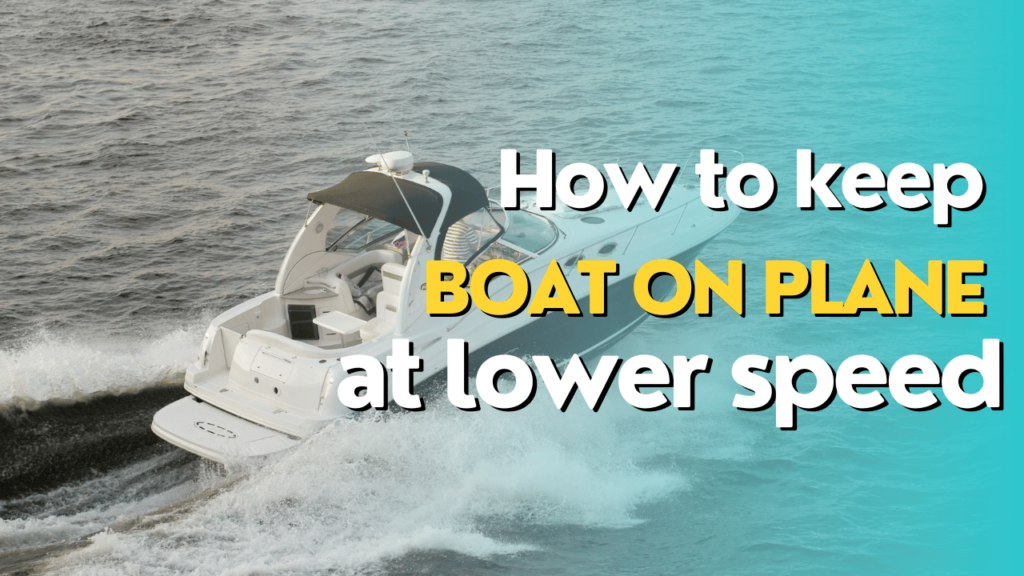
To keep a boat on plane at lower speeds, adjust the trim tabs and distribute weight appropriately. Additionally, raise the bow by applying throttle gradually, and maintain a consistent speed to prevent falling off the plane.
Properly inflating the trim tabs will provide lift, helping the boat ride on the water surface instead of plowing through it.
By distributing weight evenly and not overloading the stern, you can achieve better balance and stability. Maintaining a steady speed allows the boat to maintain lift and stay on plane, while gradual throttle adjustments raise the bow to surface the boat.
Following these techniques ensures a smooth and efficient ride at lower speeds.
You may also like to know: How to get a bass boat on plane?
Table of Contents
Maintaining Optimal Boat Speed
Maintaining an optimal speed for your boat is crucial to keep it on planing smoothly. Understanding the concept of boat planing helps in achieving this. By keeping your boat on plane at lower speeds, you can enjoy various benefits.
One of the key advantages is improving fuel efficiency.
When your boat is on plane, it consumes less fuel, making your boating experience more economical.
In addition to fuel efficiency, keeping your boat on plane at lower speeds also enhances overall performance. It allows your boat to glide effortlessly through the water, reducing drag and ensuring a smoother ride.
So, the next time you take your boat out, remember the importance of maintaining optimal speed for a more efficient and enjoyable boating experience.
Techniques For Keeping Boat On Plane At Lower Speeds
Proper weight distribution and load management are crucial for keeping your boat on plane at lower speeds.
Be mindful of how you distribute the weight on board, ensuring it is evenly spread to maintain balance.
Trim tabs can significantly enhance stability, so make sure to utilize them effectively.
Adjusting the throttle and trim will help achieve a smooth planing experience, preventing the boat from bouncing or porpoising.
These adjustments allow you to find the right balance between engine power, trim level, and speed, optimizing your boat’s performance. If you follow these techniques, you can keep your boat on plane at lower speeds for a more enjoyable and stable ride without compromising on safety or efficiency.
Fine-Tuning Your Boat For Optimal Planing Performance
Fine-tuning your boat for optimal planing performance involves optimizing fuel and weight distribution for balance. Regular maintenance ensures peak engine performance.
Adjustments are necessary based on water and weather conditions. By carefully adhering to these guidelines, you can keep your boat on plane at lower speeds while maintaining seo-friendly content.
Avoid overused phrases and start sentences with a variety of expressions to keep readers engaged. Craft unique and plagiarism-free writing that is easy to understand in active voice.
Remember, there is no need for a conclusion paragraph. Just write naturally and confidently, passing the ai writing detection as a human-like seo content writer.
Ensuring Safety While Keeping Your Boat On Plane At Lower Speeds
Ensuring safety while keeping your boat on plane at lower speeds requires understanding the limitations of boat design and load capacity.
Proper preparation and navigation strategies are necessary for planing at lower speeds. Wearing safety gear and following boating regulations are of utmost importance.
To maintain the reader’s interest, vary the phrases at the beginning of paragraphs, avoiding repetitive terms. It is essential to write in a seo-friendly, human-like manner that is unique, plagiarism-free, and easy to understand.
FAQs Of How To Keep Boat On Plane At Lower Speed:
How Can I Keep My Boat On Plane At A Lower Speed?
To keep your boat on plane at a lower speed, you can trim the engine, distribute weight evenly, and adjust the trim tabs if available. Additionally, using a hydrofoil or trim tabs can help improve planing efficiency and reduce the required speed.
Practice maintaining a steady throttle and controlling the boat’s trim to achieve optimal planing at lower speeds.
What Are The Benefits Of Keeping A Boat On Plane At Lower Speeds?
Keeping a boat on plane at lower speeds helps improve fuel efficiency, reduces engine wear, and provides a smoother ride. It allows for better maneuverability in shallow waters and helps minimize wake and environmental impact. Moreover, it enables better control when navigating through tight spots or in busy areas, enhancing overall safety and enjoyment on the water.
Why Is It Important To Maintain A Steady Throttle When Keeping A Boat On Plane At Lower Speeds?
Maintaining a steady throttle when keeping a boat on plane at lower speeds is essential for achieving and maintaining the right balance. Any sudden throttle adjustments can cause the boat to lose plane or porpoise, making it more difficult to control.
By keeping a steady throttle, you can maintain a consistent speed and smooth ride, optimizing the boat’s performance and efficiency.
Conclusion
Maintaining a boat on plane at lower speeds can greatly enhance your boating experience. By following the tips and techniques mentioned in this blog post, you can ensure a smoother and more efficient ride without compromising on speed.
First, trimming your outboard motor correctly will help lift the bow and reduce drag.
Additionally, distributing weight evenly and adjusting your trim tabs can further improve stability. Remember to gradually increase power when getting on plane and use the throttle in smooth motions to maintain balance. Keeping the boat on plane at lower speeds requires practice and attention to detail, but the benefits are well worth it.
So, the next time you hit the water, apply these strategies and enjoy a comfortable, economical, and exhilarating ride.
